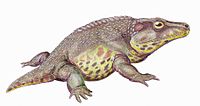Arroyo Formation
[2] It is the lower-most portion of the Clear Fork Group, part of a series of fossiliferous Permian strata in the south-central United States known as the red beds.
[5] Subsequent authors, starting with Sellars (1932), have considered the Arroyo Formation the basal part of the Clear Fork Group.
[7] "Southern area" deposits found north of Runnels County preserve a series of terrestrial mudstone layers interspersed with several distinct intervals of marine limestone, four of which having been named.
This makes it difficult to distinguish the boundary between the Arroyo and Vale Formation north of Taylor County, where it occurs shortly after the top of the Standpipe Limestone.
These fossils are probably from a later interval of the Arroyo Formation, a segment which would lie between the Kirby Lake and Standpipe Limestone layers further south.
The fauna is similar to that of the "Classic area", with Diplocaulus, Dimetrodon, and Orthacanthus fossils being the most common and Eryops and Diadectes also known, albeit from much more fragmentary remains.
[7] Between the Salt Fork Brazos and Red River, the Arroyo Formation preserves a terrestrial floodplain ecosystem found in outcrops in Baylor, Wilbarger, and Wichita counties.
[7] The portions of the Arroyo Formation exposed in this area are among the oxidized Permian sediments collectively termed the Red Beds of Texas and Oklahoma.
They are represented by Red clays, shales, and mudstones, with occasional layers of sandstone or conglomerate,[8] as well as scattered carbonate nodules which become increasingly more common in younger levels.
[10] Olson (1958) attempted to provide an informal geological boundary between the Arroyo and Vale based on the presence of an even red shale or mudstone layer.
This layer is found along a northeastern-oriented line that bisected the Clear Fork area in the western part of Baylor County.
The animal-bearing sites are among the most diverse Early Permian tetrapod assemblages in the world, with numerous remains of amphibians, pelycosaurs (mammal relatives), chondrichthyans (sharks), and eureptiles.
[12] The first specimens of the gracile eureptile Araeoscelis were discovered at the Craddock Bonebed, one of the most productive Arroyo Formation sites in Baylor County.











